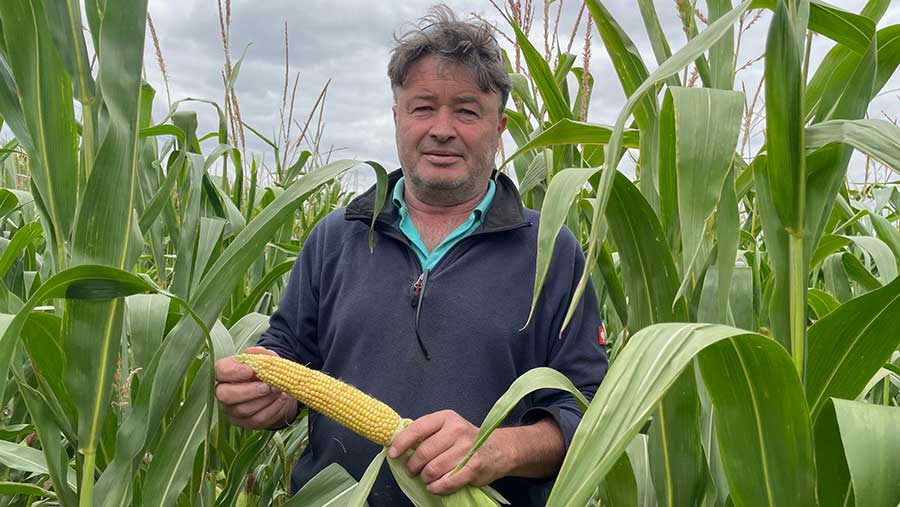Advertiser content
How smart variety choice is keeping maize in the rotation
First grown as an emergency biogas feedstock, maize has held its place in the rotation on one Hertfordshire arable farm despite the challenge of growing on very different soil types.
When the Covid pandemic brought supplies of hospitality food waste to a standstill, south Hertfordshire farmer Howard Williams needed to find an alternative feedstock for the 1.5 megawatt/hour biogas plant at Cattlegate Farm, near Enfield.
He found a solution in maize and forage rye and four years later, while food waste supplies are back on track, the plant takes up to 30,000 tonnes per annum, Howard is still growing maize.

Howard Williams © Bayer Crop Science
Farming on heavy London clay at Cattlegate Farm and on much lighter land over gravel 10 miles away at Noke Farm near St Albans, he is finding maize works well as a break crop on both soil types, both agronomically and financially.
“The supply of food waste has gone back up in the last 18 months to the point that we are now completely maxed out at our plant at home, but over the last two or three years, we’ve developed a market for the maize.
“Some goes to other AD plants, and some to livestock farms for forage,” says Howard.
“Maize is now the main break crop on the gravel farm. We still grow oilseed rape as well on the home farm, but it is surprising how well maize has lent itself to the rotation.
“We find it does well on the gravel compared to other spring break crops because it performs well when water is limited.
“We are working towards half wheat, half maize, which will be about 50 hectares of each,” he adds.
However, with the two farms’ 182ha of maize grown on two very different soil types, careful variety choice is essential, says Howard’s agronomist, Barry Williams of ProCam.
“Basically, we want the earliest variety we can get on the clay, one that can go in late and come off early.
“We have to manage what we can and create the best possible growing season in the shortest possible window, because we want to follow the maize with a first wheat.
“If we don’t follow with wheat, the system doesn’t stack up.
“On the gravel, we will grow a maincrop variety because the land travels so much more easily all year round,” says Barry.
Demo site
In 2025 Howard hosted a ProCam demo site alongside his commercial maize crop on the light land farm, giving him the chance to assess a range of varieties through the season.
Two varieties that caught his attention were the DEKALB® maincrop varieties DKC3218 and DKC2742. Both demonstrate excellent consistency across sites and seasons, says ProCam technical seed specialist Hayley Wellings.
Consistency is key. I don’t want a variety that can be the highest yielder in one year when everything is in its favour, but then the next year is in the bottom 10%.
I want something that performs from one farm to the next and from one year to the next.
“DKC3218 has been around for a few years now and while it has that consistency, DKC2742, which is a new variety, looks more interesting in terms of being slightly earlier in maturity and a step forward in yield and starch percentage,” says Hayley.
In the maize demo field at Noke Farm, the vigour of the two Bayer varieties soon became apparent.

© Bayer Crop Science
We put them in side by side and by early June, you could spot where they were in the field because they were up and out the ground that much quicker than the other varieties.
“They’ve definitely got that early vigour, which is really important when you get a season like 2025.
“If you can get a variety up to the eight-leaf stage before drought sets in, it’s got a much better chance of getting through the season,” adds Hayley.
Cob inspections just before harvest in late August revealed that varieties which had established well and grown strongly reached cob fill earlier and successfully filled their cobs, while varieties that were later to get going were more affected by the drought.
“We also had a bit of a field effect going on at the site.
“There was an area that sat quite wet in the autumn and there was some compaction there, but early on we noticed that while some of the varieties clearly struggled to get their roots down, the Bayer varieties tended to be less affected,” says Hayley.
With a variety switch on the cards for harvest 2026, DKC2742 is definitely of interest, says Howard.
“I’ve been looking at the DEKALB varieties with Barry and Hayley and they’ve looked good; you can certainly pick them out,” he says.
Strong start, big energy
Introducing DKC2742, the high output, maincrop maize from Bayer.
Powered by DEKALB®’s global maize breeding expertise and agronomic innovation, DKC2742 is built for reliability. It offers strong early vigour and reliable establishment across a range of growing conditions.
Your go-to choice for maximizing biogas yields, DKC2742 is bred for productivity, with wide leaves that capture every bit of sunlight. It boasts robust scores for eyespot and fusarium, along with excellent resistance to root lodging and brackling, standing tall right through to harvest.
DEKALB® is a Registered Trademark of the Bayer group. © Bayer CropScience Ltd 2025. All other brand names used are Trademarks of other manufacturers in which proprietary rights may exist. For further information, including contact details, visit www.cropscience.bayer.co.uk or call 0808 1969522.
Provided by
At Bayer Crop Science, we are committed to transforming the future of UK crop production by becoming the preferred partner for agronomists, distributors, and growers. Our focus is on world-leading innovation, dedicated in-field expertise, and a tailored customer experience that consistently delivers value, trust, and results sustainably.
